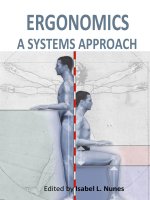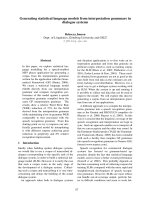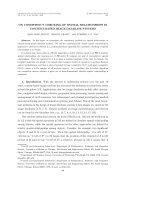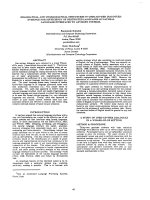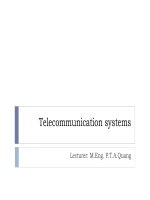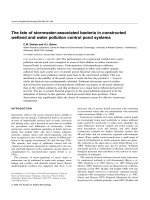Telecommunication systems potx
Bạn đang xem bản rút gọn của tài liệu. Xem và tải ngay bản đầy đủ của tài liệu tại đây (206.03 KB, 18 trang )
Telecommunication systems
Lecturer: M.Eng. P.T.A.Quang
Quality of service and telecommunication
impairments
1. Quality of service: voice, data, and image
2. The three basic impairments and how they affect the
end-user
3. Level
4. Echo and singing
Quality of service : voice, data, and image
SNR
Voice transmission
Data circuits
Video
Signal-to-Noise ratio
Measure signal quality
S/N requirement (@ receivers):
Voice: 40 dB
Video (TV): 45 dB
Data: 15dB (depend on modulation type and specified error
performance)
N
S
SNR
Voice transmission
Data circuits
BER : basic QoS parameter for data circuits.
CCITT/ITU-T recommends BER: 1x10
-6
for at least
80% of a month
Ex: 1500-byte ethernet packets transmit through
the cables have
-BER: 5x10
-7
Determine the packet error rate?
Video (television)
CCIR TASO
Impairments
Amplitude (or attenuation) distortion and Phase
distortion
Noise
Amplitude and phase distortion
Amplitude distortion:
Voice channel occupies the band from 300 to 3400 Hz
Some frequencies are attenuated more than others
Phase distortion
Velocity of propagation varies with frequency
Filter: increase toward band center and decrease toward
band edge
Amplitude and phase distortion
Noise
Thermal noise
Intermodulation noise
Impulse noise
Crosstalk
Thermal noise
caused by random electron motion and characterized by
a uniform distribution of energy over the frequency
spectrum with a Gaussian distribution of levels
Thermal noise level (P
n
) in 1Hz bandwidth @ absolute
zero (
0
K)
P
n
=-228.6 dBW per Hz for perfect receiver
@290
0
K =17
0
C
P
n
=-204dBW per Hz = ??? dBm/Hz for perfect receiver
-174
Noise figure
the difference between the noise output of the
actual receiver to the noise output of an perfect
receiver with the same overall gain and bandwidth
Generally, thermal noise level can be given by
P
n
=-204 dBW/Hz + NF
dB
+ 10 log B
B : bandwidth (Hz)
Noise calculation example
Example: Determine the thermal noise level in dBW of a
receiver with 3-dB noise figure and 10-Mhz bandwidth
Solution:
P
n
=-204 dBW/Hz + 3 dB + 10 log(10x10
6
)
=-204 dBW/Hz + 3 dB +70 dB
=-131 dBW
Intermodulation (IM) noise
two signals with frequencies F
1
and F
2
are passed through
a nonlinear device or medium, the result will contain IM
products that are spurious frequency energy components.
Impulse noise
is noncontinuous, consisting of irregular pulses or noise
spikes of short duration and of relative high amplitude.
Caused by lightning, car ignitions, mechanical switches,…
Crosstalk
unwanted coupling between signal paths.
Caused by:
Electrical coupling between transmission media, such as
between wire pairs on a voice-frequency (VF) cable system and
on digital (PCM) cable systems.
Poor control of frequency response
Nonlinear performance in analog (FDM) multiplex systems
Types:
Intelligible (4 words are intelligible to the listener from
extraneous conversation(s) in a 7-second period)
Unintelligible
Level & Echo and Signing
Refer to textbook
